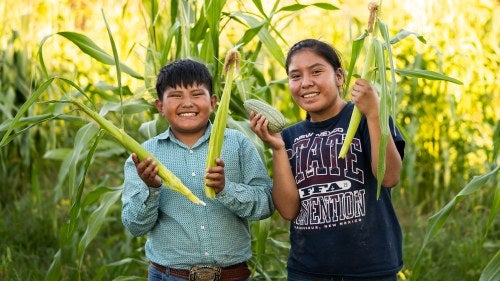Going Beyond Regenerative Agriculture on Tribal Lands

Regenerative agriculture helps build just food economies, protecting Indigenous ways of knowing despite outside pressure to conform to globalized agricultural practices.
In October of 2022, the Chicago Council on Global Affairs launched a blog series titled, “Stewardship, Sovereignty, and Solutions” that features the voices of guest authors from Indigenous organizations and communities. Recognizing that Indigenous communities around the world disproportionately experience the pressures of climate change, global conflicts, and the pandemic, while simultaneously stewarding 80 percent of the world’s biodiversity, the blog series aims to highlight Indigenous and traditional agricultural practices in the United States and globally. In bringing attention to Indigenous agriculture and foodways, we aim to promote a truly inclusive global food system that recognizes and actively counteracts the oppression of Indigenous peoples.
In Seneca Nation traditions, white corn symbolizes the nation’s strength and resiliency. It is harvested during its milky stage and roasted for roast corn soup. The Seneca people acknowledge the value placed on white corn, which is an inherent part of their culture.
As a young Seneca Nation Tribal member, Dylan1 served as a Natural Resources Intern for the Intertribal Agriculture Council (IAC) last summer and was taught to identify the corn during its different stages and roast it using an open fire pit and a mechanical corn roaster. Through his internship, he learned to honor the value of each corn stalk, each ear of corn, and even each individual kernel. This practice of valuing each unique part of the corn stalk emphasizes a regenerative approach to agriculture that is inextricably linked to Indigenous agriculture, ultimately building just food economies through policy solutions like the Regenerative Finance Model (RFM).
Regenerative Agriculture Is Indigenous Agriculture
Dylan’s internship was hosted at Gakwi:yo:h Farms, located on the Seneca Nation territory of Cattaraugus. Gakwi:yo:h Farms addresses food security and food sovereignty through community engagement and wellness by implementing a Haudenosaunee approach to agricultural practices. Through traditional teachings, the staff at Gakwi:yo:h Farms help their interns and community learn that by being good stewards of the white corn, they increase their understanding and appreciation for who they are as a people.
Dylan’s internship experience demonstrates IAC’s awareness that regenerative agriculture is synonymous with Indigenous agriculture. Not only does IAC connect Tribal members to traditional agriculture strategies on their own lands, but it also creates a pipeline of young Native people interested in developing their careers in the regenerative agriculture sector, which is an aspect of a regenerative community model. For IAC and indigenous communities, regenerative agriculture goes beyond the technical aspects of agricultural production; it is regenerative in factoring economic aspects as well to perpetuate holistic wealth in a community from generation to generation.
Indigenous-Rooted Theories of Change
In IAC’s most recently published collection of organizational success stories, a photo shows Dylan standing alongside other farmers at Gakwi:yo:h as he learns how to gut, skin, and butcher bison for meat. Bison is a traditional staple of the Seneca people, along with the white corn. Not only has Dylan learned traditional regenerative agriculture practices of his people, but he has also participated in hands-on experiences that have exposed him to his peoples’ traditional culture and way of living in alignment with the land.
No other single Native-led organization provides this kind of direct touchpoint and impact with Native producers. IAC’s Indigenous-rooted theory of change generates the single most measurable impact on Indian Country by uplifting collaborative partnerships, community-driven solutions, and rematriation of culture and food systems. Through emphasizing Indigenous ways of knowing, IAC’s theory of change also creates a system designed to enhance Indigenous agriculture through behavior and policy change. This allows Indigenous communities to protect and follow traditional knowledge ways despite outside pressure to conform to globalized agricultural practices.
In 2021, IAC documented that for every $1 invested in its programming, $14.20 in increased economic access is realized in a tribal community, emphasizing the importance of funding Indigenous communities in addition to supporting behavior and policy changes. Increased funding provides Indigenous communities with the support they need to maintain regenerative agricultural practices, specifically through internships like Dylan's. Providing young Indigenous people with the tools and knowledge to practice regenerative agriculture, these internships become a vital part of continuing Indigenous traditions and practices.
Building Just Food Economies through the RFM
Indigenous tribes’ theory of change and regenerative agriculture practices help build just food economies, and it requires adequate financial support to succeed. For example, the RFM provides Tribal producers access to capital at flexible terms that emphasize success and sustainability. The RFM continually generates its own financial support via a low-risk loan product that ensures the businesses’ revolving profits remain in the local economy. It also enhances the impacts of existing federal assistance programs by increasing the financial viability of individual agricultural operations. By replacing colonized lending practices, the IAC’s RFM model perpetually regenerates capital for producers. This redistribution of wealth promotes racial equity and supports Indigenous producers as they care for their families, communities, and lands.
“The RFM not only replenishes the landscape, but returns the wealth that was once stolen from Indigenous communities as colonizers pulled the levers of power in a way that benefitted only a select few,” said Kelsey Scott, IAC’s Director of Programming. “With the RFM, we are pulling that lever back in our favor.”
The RFM helps Indigenous communities and the IAC support Native youth, providing opportunities for them to learn about their histories and create a future that prioritizes Indigenous food and culture. For Dylan, it helped him grow his aspirations for seed stewardship and his desire to attend Cornell University’s agriculture program. He was even offered a position at the farm, with the stipulation that he graduate high school first. Through IAC’s Natural Resources Internship Program, and support from the RFM, Dylan began his career in regenerative agriculture and traditional stewardship on his own Tribal lands. All it took was the appreciation of a single kernel of corn to open an entire world of Indigenous knowledge, ultimately allowing Indigenous communities to reclaim our knowledge as power.
If you are interested in learning more about IAC, you can visit the website at www.indianag.org. For more information about how to support IAC, the RFM, or youth internship programs, contact Leah Altman, Development Director, at leah@indianag.org.
- 1
All names have been changed to protect the identity of Tribal members.


Related Content
- Embracing Dandelions as Food and Medicine
- Going Beyond Regenerative Agriculture on Tribal Lands
- Expanding "638" to Enhance Native American Food Sovereignty
- Flavors and Culture: Food Systems Through Indigenous Women's Eyes
- A Thanksgiving Legacy: Fighting for Indigenous Food Sovereignty
- Native Food Sovereignty: Strengthening Connection to Culture
- Reconnecting to Indigenous Food Sovereignty Values and Practices
- Embracing Interconnectedness: How Indigenous Foodways Can Save Us